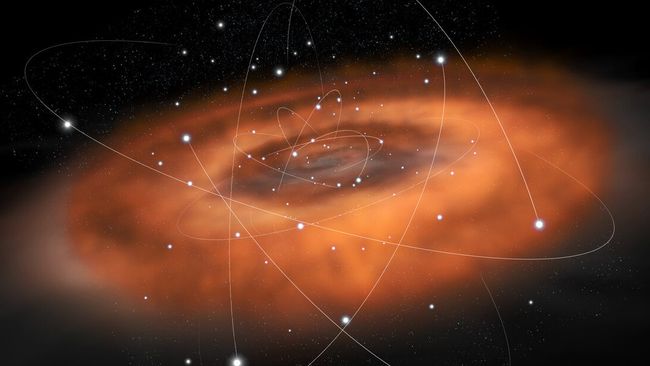Researchers propose that ‘eternal’ stars located at the core of the Milky Way galaxy could have discovered an infinite source of energy.
Conglomerations of peculiar stars located near the center of the Milky Way seem to contain stars much younger than what the existing paradigms would indicate. The current research suggests that their youths can be eternal, fueled by the destruction of dark matter.
A specific group of stars orbiting the chaotic heart of our galaxy, the Milky Way, may become effectively ‘‘eternal’’ by continually gobbling up dark matter and tearing it apart at their centers, researchers propose.
One study proposed that when dark matter particles are trapped by the gravity of these stars, they may often collide with one another within the star and annihilate into ordinary particles producing large amounts of energy.
This additional energy source could keep the star stable and perhaps even eternal after its fuel is used up, according to the researchers.
“Stars convert hydrogen in nuclear fusion,” lead study author Isabelle John of Stockholm University, a doctoral candidate in astroparticle physics told Live Science in an email interview. The outward pressure from this equals the inward pressure from the gravitational forces, and keeps the stars in a stable condition.
However, many stars observed in the vicinity of the Sagittarius A* black hole are much younger than expected based on stellar evolution models. To solve this puzzle, the researchers tried to find out if the stars could be tapping energy from the dark matter postulated to abound in the galactic core.
“If stars can accrete large amounts of dark matter which annihilicates within the star, this will provide a similar outward pressure, and so stars are stable by dark matter annihilation rather than nuclear fusion — That is stars can use dark matter as a fuel rather than hydrogen,” John added. ‘However, stars are said to run out of hydrogen, which will lead to their death whereas stars are capable of accreting dark matter perpetually. ’
The paper, shared on the arXiv preprint server in May, has not been peer reviewed yet.
Stars defying theory

Stellar evolution is a field of astronomy that has been discussed often over the years. Correlations between a star’s age, its power, diameter and temperature have been defined accurately not only in theory, but also with stars’ observational data. But recent observations have indicated that the stars in the Milky way center do not exhibit the typical characteristics that are expected as per the nucleosynthetic theory of stars.
“The innermost stars of our Galaxy, the S-cluster stars, show a series of properties that [are] not found anywhere else: Which could indicate how they are able to reach the inner regions of the galaxy where conditions are presumed to be unsuitable for star formation,” said John. Japanese scientists have also noted that the stars are much younger than they would be had the stars been formed elsewhere in the universe There also appear to be more heavyweight stars that would not have been expected.
It is because these particular S-cluster stars have some quite unusual characteristics that could be attributed to the existence of an extra energy source inside them. For instance, it could bring energy from other sources in order for the star to burn hydrogen- the normal energy source- in a slower pace hence undergoing a slower aging process and hence looking younger than the natural age.
In this recent work, John, in collaboration with Tim Linden, from Stockholm University and Rebecca K. Leane from SLAC National Accelerator Laboratory at Stanford University, proposed that this source could likely be the annihilation of dark matter particles. This explanation makes sense as it is believed that larger quantity of dark matter is present in the center of galaxy which is exactly where strange stars were seen.
“In most areas of the Milky Way, dark matter density is not very dense and does not impact the stars,” John added. However, at the Galactic Center, it is stated that the density of dark matter is numerous billion times as much as the Earth.
Virtual annihilation
To confirm their theory, the researchers modeled the complete developmental process of a star with an orbiting dark matter cloud that has as similar density to the inner galaxy. It was assumed that dark matter is made up of weakly interacting massive particles or WIMPs, one of the acknowledged types of the dark matter ingredients.
Although there is evidence suggesting the existence of dark matter particles, such as WIMPs, they have not been discovered in controlled lab and have not been observed to annihilate and in turn the strength of their interaction with ordinary matter is unknown. However, the authors of the study pointed out that this was possible if some parameters of these quantities had certain values, in which case the energy generation via the dark-matter-based mechanism fully corresponded to the S-cluster stars.
The authors cited their reason for reaching the conclusion, but the authors argue that discovering more stars that are close to the galactic center may help confirm this theory. Moreover, improving accuracy of the temperature, luminosity, metallicity, gravity and other parameters of known stars is necessary to make detailed comparisons with theories. It should be possible to make the said observations in the near future utilizing the Very Large Telescope at Paranal, Chile or the Keck Observatory in Hawaii, the researchers noted.
These stars belong to the Spectral class S and are part of the S-cluster in the vicinity of the Solar system; Further observations of the S-cluster stars will give more info about these stars and current processes, – John said. ‘This will tell whether the observations are well explained by the simulations made or whether there are other theories explain the observations’ peculiarities better’.
Do not forget to share your opinion with us to provide you with the best posts !




0 Comments